Japan awards international Tokyo Haneda Airport slots, but Narita Airport remains the main hub
Now that Japan has awarded the allocation of prized daytime international slots at Tokyo Haneda airport, it will soon become evident if airlines will add a service from Haneda or merely transfer an existing Narita service to Haneda. Japanese carriers are more likely to grow, while international carriers are more likely to shift flights to the more convenient geography of Haneda.
ANA emerged strongly from the process, receiving 11 slots to JAL's five. ANA can now have up to 24 daytime Haneda flights to JAL's 18. This uneven distribution repeated the 2012 domestic Haneda slot allocation in which ANA received eight and JAL three. But JAL received almost as many blue-chip destinations as ANA. The difference is in secondary points, which JAL perhaps would have liked - but is not nearly as upset as its rare public outcry suggests. Indeed, JAL's higher operating margin will likely see it achieve a disproportionately higher profit from the slots. Both ANA and JAL could see a boost of around USD100 million.
The focus is on Haneda, prompting some to raise the question of Narita's future. But with ample services left, and a new and growing LCC business, Narita has a place too as Japan fully starts its plan of having dual hubs in Tokyo rather than mainly international flights at Narita and domestic flights at Haneda.
Slot dispersal doubles the number of daytime slots available
The additional 30,000 annual daytime international Haneda slots comes on top of the existing 30,000 international slots at Haneda, equating to a doubling of daytime international capacity. But the existing daytime international services are only for regional Asian services, so this expansion programme will be the first time in three decades there will be long-haul daytime flights into Haneda. There are also 30,000 late night/early morning slots available, but they have not been fully taken up.
The new allocation changes the balance of international Haneda services between ANA and JAL. They had each been equal with 13 daily international flights from Haneda. Their offerings were almost identical with the exception that ANA serves Frankfurt while JAL serves Paris CDG, and ANA serves Los Angeles while JAL serves San Francisco.
ANA and JAL international daily routes from Haneda: Oct-2013
| Carrier | International Flights from Haneda, daily unless stated otherwise |
| ANA |
Los Angeles Seoul Gimpo - three daily Taipei Songshan - two daily |
| JAL |
Seoul Gimpo - three daily Taipei Songshan - two daily |
Haneda slots aim to make it Tokyo's business hub, not main airport; Narita has a substantial future
Some have speculated on the future of Narita after this slot allocation, but the approximately 30 daily slot pairs distributed represent less than 15% of Narita's approximately 230 daily international flights. And many of the slots will be used for new services rather than just shifting traffic from Narita to Haneda. A likely impact would be under 10%, and will be offset by Narita's growing LCC traffic as well as Narita's current limited slots.
The rationale behind the slots is to change the status quo at Tokyo's airports. Since about 1980 Haneda was almost exclusively a domestic airport while Narita handled international flights with some domestic services, mainly for feed.
Aircraft movements at Haneda and Narita airports: 1970-2010
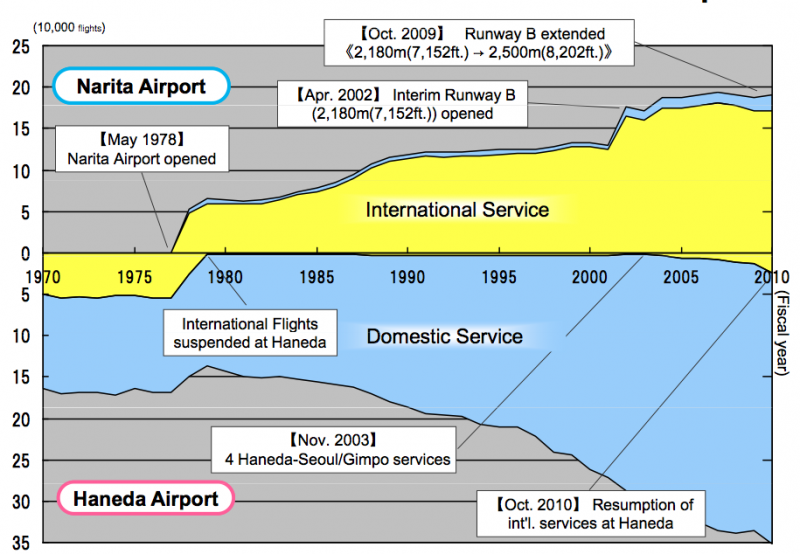
This has led to a loss of efficiency for international-domestic transfers. This shortcoming has benefitted nearby Seoul Incheon airport as Korean Air and Asiana serve a multitude of Japanese points, enabling some passengers to seamlessly transfer at Incheon rather than switch airports in Tokyo.
The aim is to keep Narita as the general international gateway but introduce Haneda as Tokyo's business hub. Haneda's more convenient positioning means airlines can attract a yield premium. ANA says it has found significant yield increases in daytime regional flights from Haneda compared to similar services at Narita.
But nighttime international services have seen about the same yield as Narita services; effectively Haneda's convenience balances out inconvenient travel times. While it may follow that long-haul flights from Haneda should see a yield boost over Narita, the longer profile of long-haul flights means passengers may be less sensitive to airport journey times than a passenger on a regional flight of only a few hours. Consequently the long-haul yield premium may not be as great as on regional services.
Location of Tokyo area airports from Tokyo (red dot)
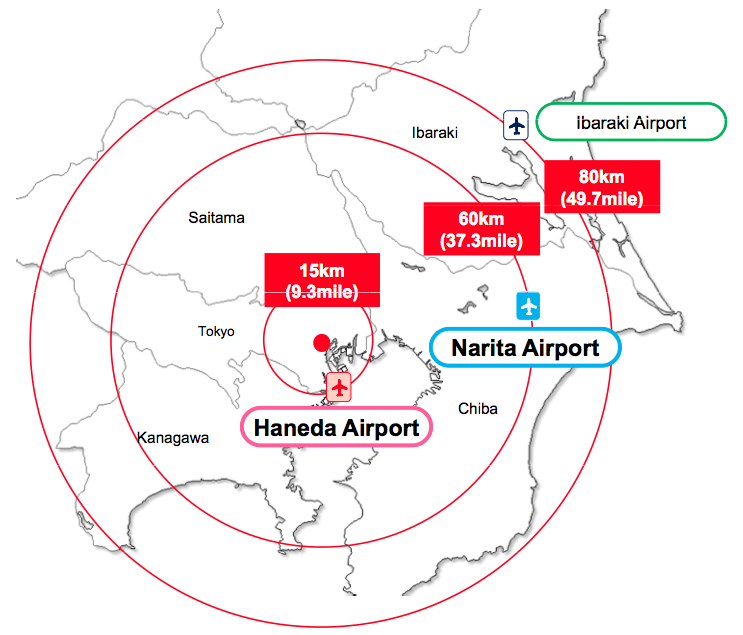
Narita's international network would also make it a hub for Asia as international transfers will be more numerous there than at Haneda, where airlines will primarily see domestic connections.
Shortly after ANA launched night international services from Haneda, it reported about 24% of passengers made domestic connections while only 3% made international connections. But Narita flights saw 17% international connections and 14% domestic connections.
Asia, then Europe, largest recipient of Haneda slots
Asia is the largest recipient of Haneda slots, with the region receiving seven. Europe receives six while North America at present receives one slot but slots to the US (expected to be four) are yet to be awarded. Delta boldly and over-optimistically asked to move its entire Narita operation back to Haneda. In the medium term, it can at best hope for a single slot or two.
See related report: Delta Air Lines seeks a Tokyo Haneda base. Skymark a potential partner, to shake up alliances?
Haneda slot dispersal for foreign carriers: Oct-2013
| Country | Slot Pair |
| Canada | 1 |
| China | 2 |
| England | 2 |
| France | 2 |
| Germany | 2 |
| Indonesia | 1 |
| Singapore | 2 |
| Thailand | 1 |
| Vietnam | 1 |
Dispensation is given to Indonesia and Vietnam to allow them to combine their one daytime slot pair with a nighttime pair. So one flight may arrive using the nighttime slot but then depart with a daytime slot. Another flight would arrive with a daytime slot and then depart with a nighttime slot. Unless schedules are put close to the 23:00 and 06:00 cut-offs, there could be long layovers involved if taking up this offer.
Haneda slots are to connect the airport with key business centres - but some political moves evident
Haneda slots were in theory to be awarded to countries that offered major business destinations that should be connected with Tokyo's convenient downtown airport, so the abstract argument went. Clear criteria were never established. Regulators would have looked kindly on airlines that stuck out nighttime slots. These slots, to be used about between 23:00 and 06:00 in at least one direction, limited connections and ground transport options.
An 06:00 departure would have required an early wake up for the passengers, in theory mainly business travellers. British Airways for now has persevered, offering a less than daily London Heathrow-Haneda service. American Airlines cancelled and then resumed its New York JFK-Haneda flights on a few occasions. Air Canada's case offers another extreme. Air Canada announced its Haneda plans with great fanfare but never implemented them.
But it seems Japan was also influenced by political jockeying, which was to be expected. Indonesia and Vietnam are not even in Japan's top 11 international markets. Nor is Canada, for that matter. Korea (largest market) and Taiwan were some of the overlooked candidates, either due to Japanese carriers not being interested in more access or the other sides being unable to offer more slots at their respective downtown airports, Seoul Gimpo and Taipei Songshan.
Japan international seat capacity by country: 7-Oct-2013 to 13-Oct-2013
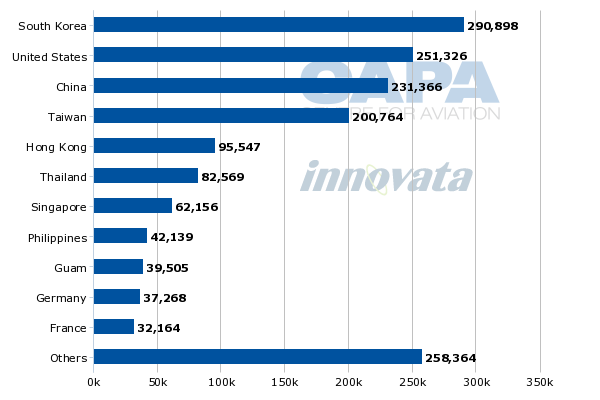
Capacity is limited to Indonesia and Vietnam. Indeed, it has only been in recent years Garuda for one linked Tokyo to Jakarta with a non-stop flight. While the slots may be used, there are questions if the slot could have seen higher value maximisation.
ANA receives 11 slots while JAL receives only five
Prior to the latest allocation, ANA called on the regulator to limit slot awards to JAL. JAL argued for an even distribution. ANA's view is that JAL received too much government help during its bankruptcy restructuring and ongoing tax benefits. This has also meant that JAL has achieved a lower operating cost than ANA, which was once the country's efficient airline. ANA saw the Haneda slot distribution as an opportunity to "correct" JAL's advantages. Other arguments centred on JAL not receiving public benefits since it previously received government aid. The story is further complicated by politics as the current ruling party is different from the one that bailed out JAL and is critical of the bailout.
JAL has gained an advantage over ANA because of its restructuring. But the opposing view is that slots are a public asset and should be distributed according to what will benefit the public most, and not what will settle airline or political quarrels.
Some see the slot distribution as part of a larger agenda to balance Japanese aviation. JAL was once the international behemoth but under restructuring cut so much capacity that it is only slightly larger than ANA (which is the larger carrier in the domestic market). Therefore awarding more international slots to ANA than JAL may further close the gap.
Haneda slot dispersal for ANA and JAL: Oct-2013
| Country | ANA | JAL |
| Canada | 1 | - |
| China | 1 | 1 |
| France | 1 | 1 |
| Germany | 2 | - |
| Indonesia | 1 | - |
| Philippines | 1 | - |
| Singapore | 1 | 1 |
| Thailand | 1 | 1 |
| UK | 1 | 1 |
| Vietnam | 1 | - |
ANA has welcomed the decision while JAL, in a rare move of protest by a Japanese corporation, said it could not accept the rationale and asked the government for an explanation. There are questions if the allocation serves the public or those that influence the government; the exact process for allocation has not been disclosed.
This raises again a significant shortcoming in Japan's regulatory structures. The absence of clear, transparent administrative processes in matters such as slot allocation - with potentially massive financial implications for the operators - leaves the system exposed to the vagaries of politics. Not only does this leave decision making open a range of unsuitable influences, but also undermines broader strategic economic goals.
Meanwhile, four US slots are still to be distributed, and the expectation is ANA and JAL will each receive two.
Impact on global alliances is limited, although Star receives a bump
But not all slots are created equal. JAL has received first-tier slots, such as to China and the UK. ANA has received those too, but also what might be considered secondary priorities, like the Philippines.
An exception is Germany, where ANA has received both slots. Combined with existing nighttime slots, this means Star Alliance (members ANA and Lufthansa) will have a monopoly on Germany-Haneda slots. Although there is a JV between ANA and Lufthansa (and Austrian and SWISS), London slots were distributed to both ANA and JAL rather than only JAL, which has a JV with British Airways (and Finnair).
So aside from Germany, and providing the forthcoming US slot distribution is even, the awarding of more slots to ANA than JAL is probably more symbolic than bringing a business-changing detriment. ANA's Star comes out slightly ahead, but there is no significant impact on JAL's oneworld alliance. While IAG and American Airlines have expressed negative sentiments about the unequal distribution, it is difficult to see them being impacted by JAL not receiving an Indonesian slot. (IAG may have more legitimate qualms due to the German slot monopoly held by ANA and Lufthansa.)
Some have flagged that after the allocation Star Alliance will have about half the daytime Haneda slots, while oneworld will only have a quarter. But there are few implications since the alliances do not compete as a single business entity. While ANA and Singapore Airlines, both in Star Alliance, will have the majority of Japan-Singapore slots, that means little to ANA and SIA, who will compete aggressively with each other.
There may be arguments that Star's higher number of daytime Haneda slots increases the appeal for travellers to chose ANA and Star over JAL and oneworld. But this is reflective of Star being larger than oneworld in Asia. oneworld has no partner in China, Thailand or Singapore - all markets that have been awarded Haneda slots and have a oneworld carrier. Oneworld's only other Asian hubs are in Hong Kong (Cathay Pacific) and recently Malaysia (Malaysia Airlines).
Overall, oneworld accounts for only 11% of seats in Asia-Pacific to Star's 20%. And this figure is distorted in oneworld's favour as it includes Australia, home to oneworld's Qantas.
Asia-Pacific capacity share: 7-Oct-2013 to 13-Oct-2013
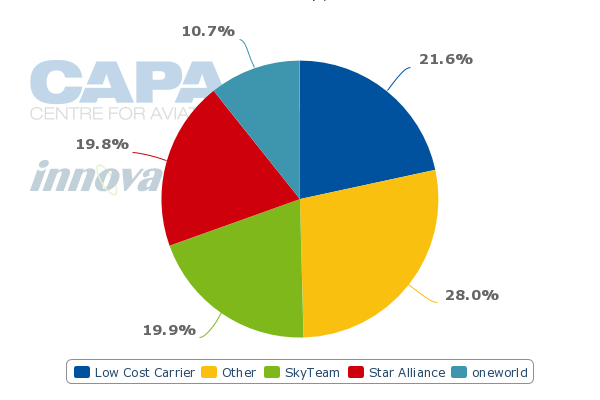
Additional services could boost ANA and JAL's profits by around USD100 million
ANA and JAL have not yet announced their route schedule for the new Haneda services but it is possible to estimate what the schedule will look like and what the profit impact could be. CAPA forecasts ANA and JAL's additional Haneda slots could boost profits by approximately USD100 million.
This is significantly less than the USD20 million profit per slot pair some have forecast. Even allocating for a yield premium, high load factor and high operating margin, this sum seems fanciful. Although ANA will receive more slots than JAL, JAL's leaner operation translates to a higher margin, so it is possible profits could be similar - or at least not as different as the wide gap in slot allocation suggests. But this is still a tidy boost to earnings: ANA's FY2012 profit was JPY97 billion (USD1,168 million) while JAL's was JPY195 billion (USD2,353 million). It will take some time for the full impact to be realised due to start-up costs.
But the profit impact will be limited if ANA and JAL use the new slots to transfer existing services, either from Narita or late night/early morning services from Haneda. For example, ANA in Oct-2013 has two daily flights to Frankfurt: one from Haneda and one from Narita. Utilising its two additional German slots for only growth would produce four daily ANA flights to Frankfurt; this would be over-kill. The Narita service has the benefit of connecting to ANA's international network at Narita, which is larger than at Haneda.
While ANA's existing Haneda-Frankfurt service uses late night/early morning slots, there is an upside as the 01:00 departure from Haneda gives an approximately 06:00 arrival into Frankfurt, allowing for a full day's work or connection from the hub of JV partner Lufthansa.
Yet the picture becomes blurred as transferring a route to a daytime Haneda slot means the airline is not using additional aircraft, so its order backlog can be used to open more routes. If a Haneda slot was used to create an entirely new service without a pull-down elsewhere, a new aircraft would be required.
How many Haneda routes will be entirely new versus transfers from Narita?
ANA and JAL will use more Haneda daytime slots for growth than international carriers will. Virgin Atlantic has already stated it intends to move its London Heathrow-Narita service to Haneda. American Airlines has said it is asking for a better daytime slot so it can adjust its New York JFK-Haneda service.
American has struggled with its JFK-Haneda service, bringing it on and off, and initially running it concurrently to a JFK-Narita service before making Haneda its sole Japan flight from New York. Delta cancelled its Detroit-Haneda service and asked to move it to Seattle, which it was permitted to do after fierce protests from US carriers as Delta was awarded the Haneda rights for Detroit. The other carriers argued a new evaluation should begin.
American Airlines weekly frequencies from New York JFK to Tokyo airport: 2011-2013
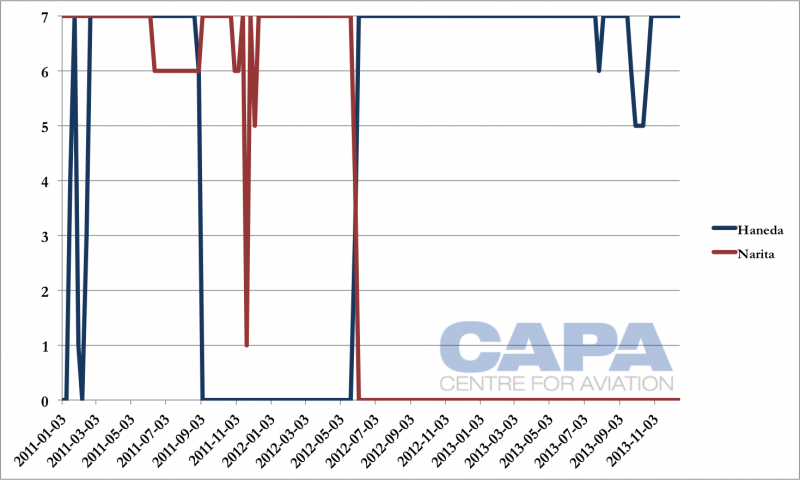
The larger picture is that many international airlines will be unconvinced Japan offers near-term volume growth for them, and so will move a Narita flight to Haneda rather than launch a new service to Haneda. Some carriers are constrained: British Airways and Virgin Atlantic are restricted because of Heathrow slots (BA will slowly convert some bmi slots to long-haul services, but its wish list of destinations is surely big) while Lufthansa is planning Asian growth through up-gauging rather than frequency growth.
Air France has a Narita-Paris CDG departing Narita at 21:55, about one hour before Narita's 23:00 curfew. But the service arrives into Paris CDG at 03:50. Air France will likely want to shift this service to curfew-free Haneda, where a later evening departure facilitates a more convenient approach into Paris.
The near-term consensus favours foreign carriers moving Narita services to Haneda. An exception may be some Asian carriers, which overall are seeing strong growth. But few have been restricted in Japan, so they could have launched additional services by now if they pleased. Medium and long term projections if these slots are merely used to transfer existing services or produce new ones will depend how successful Japan is with an economic rebound.
Service transfers will be limited as the A380 will not be permitted at Haneda during the day
A further factor for airlines is that the A380 will not be permitted to operate at Haneda during the daytime.
Japanese authorities say A380 movements during the day will require greater separation, partially for wake turbulence, thus reducing the operational efficiency of Haneda. Late night/early morning A380 movements will be authorised once all construction work on runway C finishes.
Long-haul A380 operators to Narita in Oct-2013 are Air France (Paris CDG), Lufthansa (Frankfurt) and SIA (Singapore-Tokyo Narita-Los Angeles).
Last slot awarding for medium term, at least until the Olympics
Once the US slots are awarded, this will conclude the slot dispersal at Haneda for the medium term. Haneda has no further runway or terminal construction plans. But entrepreneurial airline executives are seizing on Tokyo's successful 2020 Olympic bid to push for further growth at Haneda. More growth at Haneda is probably inevitable.
Japan will need to manage relations with Narita, and also ensure there are tangible economic benefits from the massive infrastructure costs if the slots are merely shifting flights. So Narita should not be staying up too late at night, especially with the new LCCs it is receiving.
As for Haneda, 2020 will be closer than it seems.